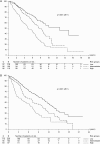New validated prognostic models and prognostic calculators in patients with low-grade gliomas diagnosed by central pathology review: a pooled analysis of EORTC/RTOG/NCCTG phase III clinical trials
- PMID: 24049111
- PMCID: PMC3813419
- DOI: 10.1093/neuonc/not117
New validated prognostic models and prognostic calculators in patients with low-grade gliomas diagnosed by central pathology review: a pooled analysis of EORTC/RTOG/NCCTG phase III clinical trials
Abstract
Background: In a previous study, the European Organisation for Research and Treatment of Cancer (EORTC) reported a scoring system to predict survival of patients with low-grade gliomas (LGGs). A major issue in the diagnosis of brain tumors is the lack of agreement among pathologists. New models in patients with LGGs diagnosed by central pathology review are needed.
Methods: Data from 339 EORTC patients with LGGs diagnosed by central pathology review were used to develop new prognostic models for progression-free survival (PFS) and overall survival (OS). Data from 450 patients with centrally diagnosed LGGs recruited into 2 large studies conducted by North American cooperative groups were used to validate the models.
Results: Both PFS and OS were negatively influenced by the presence of baseline neurological deficits, a shorter time since first symptoms (<30 wk), an astrocytic tumor type, and tumors larger than 5 cm in diameter. Early irradiation improved PFS but not OS. Three risk groups have been identified (low, intermediate, and high) and validated.
Conclusions: We have developed new prognostic models in a more homogeneous LGG population diagnosed by central pathology review. This population better fits with modern practice, where patients are enrolled in clinical trials based on central or panel pathology review. We could validate the models in a large, external, and independent dataset. The models can divide LGG patients into 3 risk groups and provide reliable individual survival predictions. Inclusion of other clinical and molecular factors might still improve models' predictions.
Keywords: low-grade glioma; predictive accuracy; prognostic factors.
Figures


References
-
- van den Bent MJ, Afra D, de Witte O, et al. Long-term efficacy of early versus delayed radiotherapy for low-grade astrocytoma and oligodendroglioma in adults: the EORTC 22845 randomised trial. Lancet. 2005;366(9490):985–990. - PubMed
-
- Kiebert GM, Curran D, Aaronson NK, et al. Quality of life after radiation therapy of cerebral low-grade gliomas of the adult: results of a randomised phase III trial on dose response (EORTC trial 22844). EORTC Radiotherapy Co-operative Group. Eur J Cancer. 1998;34(12):1902–1909. - PubMed
-
- van den Bent MJ. Can chemotherapy replace radiotherapy in low-grade gliomas? Time for randomized studies. Nat Rev Neurol. 2010;6(12):695–701. - PubMed
-
- Kros JM, Gorlia T, Kouwenhoven MC, et al. Panel review of anaplastic oligodendroglioma from European Organisation For Research and Treatment of Cancer Trial 26951: assessment of consensus in diagnosis, influence of 1p/19q loss, and correlations with outcome. J Neuropathol Exp Neurol. 2007;66(6):545–551. - PubMed
Publication types
MeSH terms
Grants and funding
LinkOut - more resources
Full Text Sources
Other Literature Sources
Medical

